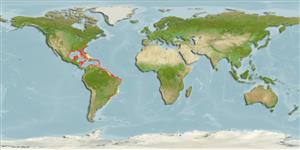Common names from other countries
Environment: milieu / climate zone / depth range / distribution range
Ecologie
; diepteverspreiding 0 - 101 m (Ref. 83435). Tropical
Western Atlantic.
Length at first maturity / Size / Gewicht / Leeftijd
Maturity: Lm ? range ? - ? cm Max length : 3.5 cm DL mannelijk/geslacht niet bekend; (Ref. 83435)
Maximum depth from Ref. 104365. In Belize, it was found in a submarine cave near Columbus Cay (Ref. 87209). Epibiotic, sessile, on hard substrate (Ref. 104365).
Life cycle and mating behavior
Geslachtsrijpheid | Voortplanting | Kuitschieten | Eieren | Fecundity | Larven
Members of the class Bivalvia are mostly gonochoric, some are protandric hermaphrodites. Life cycle: Embryos develop into free-swimming trocophore larvae, succeeded by the bivalve veliger, resembling a miniature clam.
Gischler, E. and R.N. Ginsburg. 1996. (Ref. 86352)
Status op de Rode Lijst van het IUCN (Ref. 130435)
Status bij CITES (Ref. 108899)
Not Evaluated
Not Evaluated
Gebruik door de mens
| FishSource |
Tools
Meer informatie
Leeftijd/Grootte
Groei
Lengte-gewicht parameters
Lengte-lengte parameters
Morfologie
Larven
Abundantie
Internet-bronnen
Estimates based on models
Preferred temperature
(Ref.
115969): 21.8 - 27.9, mean 24.8 (based on 424 cells).
Prijsklasse
Unknown.
